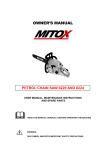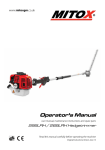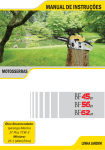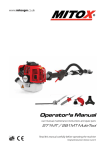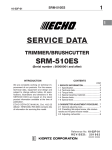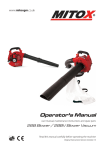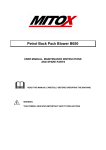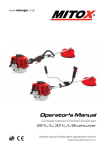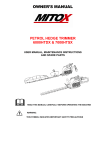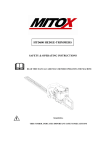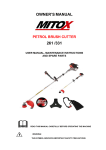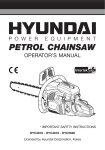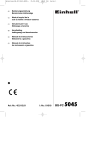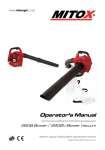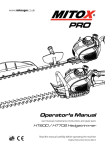Download Mitox 4518 Owner`s manual
Transcript
OWNER’S MANUAL PETROL CHAIN SAW 4518 AND 5020 USER MANUAL, MAINTENANCE INSTRUCTIONS AND SPARE PARTS READ THIS MANUAL CAREFULLY BEFORE OPERATING THE MACHINE WARNING: THIS SYMBOL INDICATES IMPORTANT SAFETY PRECAUTIONS Safety Precautions INTRODUCTION • Read this Owner/Operator Manual carefully. Be sure you understand how to operate this chainsaw properly before you use it. Failure to do so could result in serious injury. • Keep this manual handy so that you may refer to it later whenever any questions arise. Also note that you are able to contact the dealer from whom you purchased the product for assistance. • Always include this manual when selling, lending, or otherwise transferring the ownership of this product. • This product has been designed to be used as a chain saw and it should never be used for any other purpose, doing so could result in unforeseen accidents and injuries occurring. • This chainsaw is equipped with extremely sharp saw chain, and when used incorrectly the saw chain can be dangerous. • When using this chainsaw for the first time, take the chain saw to a wide, clear, open space, start the engine, and practice handling the chain saw until you are sure that you will be able to handle it properly in actual operation. • You should never use this chainsaw when under the influence of alcohol, suffering from exhaustion or lack of sleep, suffering from drowsiness as a result of having taken medicine, or at any other time when your judgment might be impaired or that you might not be able to operate the chain saw properly and in a safe manner. • Never allow children or anyone unable to fully understand the directions given in this manual to use this chain saw. • When planning your work schedule, allow plenty of time to perform the work and allow plenty of time for rest. Limit the amount of time you continuously use the chain saw to 30~40 minutes per session, and take 10~20 minutes of rest between work sessions. Also try to keep the total amount of work performed in a single day to 2 hours. • Do not climb the tree and operate the chain saw unless you are specially trained to do so. • Avoid running the engine indoors. The exhaust gases contain harmful carbon monoxide. ■ Never use the chain saw in conditions as described below: • When the ground is slippery or when other conditions exist which might make it difficult to maintain a steady posture while using the chain saw. • At night, at times of heavy fog, or at any other times when your field of vision is limited and it would be difficult to gain a clear view of the area where the chain saw is to be used. • In heavy rain, during lightning storms, at times of strong or gale-force winds, or at any other times when weather conditions might make it unsafe to use this product. • Lack of sleep, tiredness, or physical exhaustion results in lower attention spans, and this in turn can lead to accidents and injury. ■ Helmet with face protector & ear defenders WORK CLOTHING AND SAFETY EQUIPMENT When using the chain saw, we recommend using clothing with chainsaw protection: • Helmet, face protector visor and ear defenders • Gloves with chainsaw protection. • Trousers with chainsaw protection. • Boots with chainsaw protection, steel toe caps and non slip sole. Chainsaw Protection Gloves Chainsaw Protection Trousers Boots With Chainsaw Protection ■ SAFETY AND OPERATION • This chain saw is equipped with a very sharp saw chain, and when used incorrectly the saw chain can be extremely dangerous. • Improper handling can cause accidents which may in turn lead to serious injury or death. For this reason, you should always be careful to adhere to the following instructions when using your chain saw. • Never hold the chain saw in a way in which the saw chain is pointed towards someone else. • Never allow the saw chain to come into contact with your body while the engine is in operation. • Always turn off the engine before adjusting the chainsaw, removing branches which have become stuck in the saw chain, or at any other time when coming into close proximity with the saw chain. • Always wear chainsaw safety gloves when adjusting the chainsaw. • Always place the guide bar cover provided over the saw chain when not in use. • Falling branches may fall onto the operators body or head, resulting in injuries, scratches, and cuts, and for this reason you should always wear a chainsaw helmet and chainsaw safety clothing when operating the chain saw. ■ SAFE HANDLING OF FUEL • The engine of the chain saw is designed to run on a two stroke fuel/oil mixture. This fuel is highly flammable, never store cans of fuel or refill the fuel tank in any place where there is a source of heat or fire which might ignite the fuel. • Do not smoke whilst operating the chain saw or refilling, keep lit cigarettes away from the chain saw at all times. • When refilling the fuel tank always stop the engine first and carefully make sure that there are no sparks or open flames anywhere nearby before refuelling. • If any fuel spillage occurs during refuelling, use a dry rag to wipe any fuel which has been spilled onto the chain saw before starting the engine. • After refuelling, screw the fuel cap back tightly onto the fuel tank and carry the chain saw to a spot 5 metres or more away from where it was refuelled before starting the engine. ■ BEFORE OPERATING THE CHAIN SAW • Before beginning work, carefully check the work area and remove any obstacles and clear a retreat path from falling trees. • Within a perimeter of 15 metres of the work area should be considered a hazardous area into which no one should enter while the chain saw is being used, and when necessary this area should be marked with a warning rope, warning signs, or other forms of warning. When work is to be performed simultaneously by two or more operators, care should also be taken to constantly look around to check the presence and locations of other operators within the work area to maintain a safe distance between each operator. • Before beginning work, each component of the chain saw should be checked to make sure that it is in proper working order, make sure that there are no loose screws or bolts, fuel leaks, ruptures, dents, or any other problems which might interfere with safe operation. Be especially careful to check that there is no damage to the saw chain or chain brake. • Never use the chain saw when the saw chain, guide bar or sprocket are excessively worn, or blunt, or when any sort of damage has occurred. • Keep all parts of your body away from the chainsaw chain when the engine is running. ■ BEFORE STARTING THE ENGINE • Carefully check the work area to make sure that no obstacles exist within a perimeter of 15 metres around the chain saw before starting the engine. • To start the engine, place the chainsaw onto the ground in a flat clear area and hold it firmly in place to ensure that neither the saw chain or the throttle come into contact with any obstacles when the engine starts. • After starting the engine, make sure that the saw chain stops moving when the throttle trigger is released (idle). If the saw chain continues to move when the engine is at idle, adjust the idle screw on the carburettor to a point where the saw chain stops moving, if this cannot be achieved, take the chain saw to your authorised servicing dealer for adjustment. ■ AVOID NOISE PROBLEMS • Check and follow the local regulations for sound level and hours of operations for garden machinery. • In general, operate chain saws between 8 am, and 5 pm on week days and 9 am to 5 pm.weekends. • Avoid using the chain saw late at night and/or early in the morning. ■ SAFETY WHEN USING THE CHAIN SAW • When using the chain saw, grip the handles firmly with both hands, place your feet slightly apart so your weight is distributed evenly across both legs, and always maintain a steady even posture while working. • Maintain full engine speed when cutting. • Never allow other persons to come within the work area as doing so might expose them to danger. • Keep work area clear of all persons, particularly small children and pets. Injury may result from flying debris. • If a branch or other object gets caught in the saw chain during operation, always stop the engine before removing the object. • To protect yourself against injury from falling branches, wear the required safety equipment. • Never touch the spark plug or plug HT cable while the engine is in operation, doing so may result in an electrical shock. • Never touch the exhaust, spark plug, or other parts of the engine while the engine is in operation or immediately after shutting down the engine. These parts reach high temperatures during operation and doing so could result in serious burns. • When you finish cutting in one location and wish to continue work in another area, stop the engine, place the protective cover over the guide bar, and turn the chain saw so that the saw chain faces away from your body before carrying it to the new location. • Always remove fuel from the fuel tank before transportation to prevent fuel spillage. • Never leave the chain saw exposed to direct sunlight as this can heat the fuel tank and may cause a discharge of fuel, and flood the engine. ■KICKBACK AND PINCHING SAFETY PRECAUTIONS ■ BEWARE OF KICKBACK Kickback can occur whenever the tip of the guide bar touches an object when the chain saw is operating. Kickback may force the guide bar up and back towards the operator at speed. ■BEWARE OF PINCHING Pinching the saw chain along the tip of the guide bar may force the guide bar back rapidly toward the operator. Pinching can occur whenever wood closes around the moving saw chain. Both kickback and pinching may cause the operator to lose control of the chain saw, which could result in serious personal injury. • Understand kickback and pinching. • Keep a firm grip on the chain saw with both hands whenever the engine is running. • A firm grip will help you reduce the affects of kickback and pinching as well as maintaining safe control of the chain saw. • Cut at full engine speeds. • Follow the manufacturer's instructions for sharpening and maintaining the chain. • Use only genuine spare parts. ■ SAFETY SYMBOLS 6. Beware of objects being thrown from the operating zone. 1. Warning, Danger, Caution 7. Warning! Danger of kickback 2. Read the documentation and safety instructions which are provided in this user manual. 8. Directive 2000-14/CE. Guaranteed noise levels. 3. When operating the chainsaw, use protective equipment, helmet, visor, ear defenders, and chainsaw safety clothing. 9. Danger: risk of exhaust fumes intoxication. 4. Use the chain saw with two hands. 10. Danger: risk of fire or explosion. 5. Keep hands and feet away from moving parts. Always keep a safe distance from the saw chain. 11. Hot surface, risk of burn. ■ Taking care of warning labels Always keep warning labels clean and free of scratches, which might make them illegible or difficult to read. If the warning labels provided with your chain saw become damaged, peel off, or otherwise become illegible or difficult to read, order new labels from the authorised servicing dealer and replace the damaged labels. When applying new labels, first wipe away any dirt and dry the surface before applying the new label in the same place as the original label. ■ EXPLANATION OF SYMBOLS ON THE MACHINE For safe operation and maintenance, symbols are carved in relief on the machine: FUEL TANK Fuel tank 2 stroke mix Position: Fuel cap CHAIN OIL Chain oil tank Position: oil cap IGNITION SWITCH Setting the switch to the “O” position, the engine stops immediately. Position: Left of the rear handle. CHOKE OPERATION Starting mode when the engine is hot. (choke off) Position: Air cleaner cover. Starting mode when the engine is cold. (choke on) Position: Air cleaner cover. CARBURETOR ADJUSTMENTS The screw under the “H” stamp is High-speed adjustment screw. Position: Left side of top cover The screw under the “L” stamp is Slow-speed adjustment screw. Position: Left side of top cover The screw the “T” stamp is Idle adjustment screw. Position: Left side of top cover CHAIN BRAKE OPERATION Shows the directions that the chain brake is Released (white arrow) and Activated (black arrow). Position: Front of chain brake cover ■ INSTALLING THE GUIDE BAR AND CHAIN Power unit Plug wrench Guide bar cover Guide bar Saw chain ■ The chainsaw package contains the items as illustrated. 1. 2. 3. 4. 5. 6. Power unit Guide bar cover Guide bar Saw chain Plug wrench Owner’s manual. Cutting direction Open the box and install the guide bar and saw chain on the power unit as follows: (4) The saw chain is very sharp. Use chainsaw protective gloves for safety. 1. Pull the chain brake lever towards the front handle to check that the chain brake is off. 2. Loosen the nuts and remove the chain cover. 3 . Fit the guide bar over the bar bolts. 4. Fit the saw chain to the drive sprocket and while fitting the saw chain around the guide bar, adjust the position of the chain tensioner located in the side cover to fit into the tension adjustment hole in the guide bar. 5. Fit the chain cover to the power unit and fasten the nuts finger tight. 6. While holding up the tip of the guide bar, adjust the chain tension by turning the tensioner screw until the chain does not sag from the underside of the guide bar. 7. Tighten the bar nuts securely to 12/15N.M with the bar held upwards, then check the chain for smooth rotation and proper tension by rotating the chain by hand in a clockwise direction when viewed from the chain cover side. A new chain will expand in length at the beginning of use. Check and readjust the tension frequently, as a loose saw chain can easily derail or cause rapid wear to itself and the guide bar and sprocket. (6) Chain tension screw It is important to maintain the proper chain tension. Rapid wear of the guide bar or the saw chain becoming derailed can be caused by improper tension, especially when using a new saw chain. ■ TWO-STROKE FUEL WARNING • Fuel is very flammable. Do not smoke or bring any flame or sparks near fuel. Always stop the engine and allow it cool before refuelling. Refuel outdoors on bare ground, restart engine at least 5m away from the refuelling stop. The engine is lubricated by oil mixed into petrol. Prepare a mixture of unleaded petrol and semi-synthetic twostroke oil that meets the specifications of: API TC, ISO-L-EGC, JASO FC (Low Smoke) oil. Recommended mixing ratio is 32:1. • FUEL WITH NO OIL (RAW PETROL) will cause severe damage to the engine which is not covered by manufacturers warranty. • Use fresh, unleaded petrol (95 RON) and semi-synthetic oil specially made for high performance two-stroke engines. Mix in a ratio of 32 parts petrol to 1 part of oil. • By using two-stroke oil specially made for two-stroke engines you will reduce the formation of ash and carbon deposits on the spark plug, piston, exhaust muffler and cylinder as well as reducing emissions of harmful exhaust gases. • Oil FOR 4-CYCLE ENGINES should not be used as two stroke lubrication oil as it can cause fouling of the spark plug, exhaust port blocking, piston ring sticking and other internal engine damage. ■ FUEL STORAGE • Mixed two stroke fuel which has been left unused for a period of one month or more may damage the carburettor and result in the engine failing to start or operate correctly. • When storing the chainsaw for a period of more than one month, empty the fuel tank, and run the engine to empty the carburettor of fuel. • Two stroke fuel can cause deterioration of rubber and/or plastic components during prolonged storage. • It is important to only use good quality, fresh fuel mix. ■ FUELLING • Shake the fuel container to thoroughly mix the two-stroke oil and petrol. • Clean dirt and sawdust from around the fuel cap before removing. • Pour two-stroke fuel into the fuel tank with a filtered funnel, up to 80% of the fuel tanks capacity. • Replace the fuel cap and tighten securely. Spilled fuel must be wiped away from the chain saw before starting the engine. • Move at least 5m away from the refuelling area before restarting the engine. ■ CHAIN OIL- GUIDE BAR AND SAW CHAIN LUBRICATION • Chain oil lubricates the saw chain and guide bar during operation, • We recommend the use of SAE30 grade chain oil with good adhesion (anti-fling) characteristics. • Fill the chain oil tank every time you fill the fuel tank. • Failure to lubricate the guide bar and saw chain will result in overheating of these components resulting in premature wear or permanent damage. • Do not use waste or regenerated oil that can cause damage to the oil pump and harm the environment. ■ STARTING THE ENGINE • Keep clear of the saw chain as it will start rotating when engine starts. • Fill fuel and chain oil tanks respectively, and tighten the caps securely. z Saw chain Oil Two stroke fuel • Set the ignition switch to “I” position (c). (a) Choke closed (b) Choke open (d) Decompressor (c) Ignition switch • Push in the decompressor button (d). • Pull out the choke lever to the closed position (a). The choke will close and the throttle will be set in the starting position. • Place the saw on the ground, grip the front handle with your left hand, place your right foot through the rear handle. Pull the starter handle with your right hand. • CAUTION do not pull the starter cord all the way out and do not let go of the starter handle when the cord is extended, this can damage the starter mechanism. • When the engine has fired, push in the choke lever in (b) and then pull the starter handle again to start the engine. • Allow the engine to warm up; pulling the throttle lever slightly will reset the throttle control and allow the engine to idle. ■ Starting hot engine • Set the ignition switch to “I” position (c). • Pull the choke lever to closed position (a), then push the choke lever to the open position (b), this will set the throttle to the hot start position. • Push in the decompressor button (d). • Pull the starter handle until the engine runs. • Pulling the throttle lever slightly will reset the throttle control allow the engine to idle. ■ Overchoking Should the engine become flooded due to overchoking, turn the ignition switch off, unscrew the spark plug, wipe it dry or replace, pull the recoil starter several times without the spark plug in place and with choke in the open position (b). This will help clean and ventilate the combustion chamber. ■ CHAIN BRAKE • The chainsaw is equipped with an automatic chain brake to stop the saw chain rotation when activated, eg kickback during saw cutting. The brake is automatically operated by inertial force, which acts on the weight fitted inside the chain brake handle. The brake can also be operated manually when the brake handle is pushed forward towards the guide bar. • To release the chain brake, pull back the brake handle toward the front handle until a “click” sound is heard. The chain brake is now reset and the saw chain is able to rotate. How to check: • You must check the chain brake operation before each usage by running the chainsaw at full throttle for 1-2 seconds and pushing the chain brake handle forward (b). • The saw chain should stop immediately with the engine at full speed. • If the saw chain is slow to stop or does not stop, replace the chain brake band or chain brake assembly before use. • Disengage the chain brake after testing. (a) (a) (b) (a) Chain brake disengaged (b) Chain brake engaged ■ KICKBACK SAFETY PRECAUTIONS FOR CHAIN SAW USERS Kickback may occur when the nose or tip of the guide bar touches an object, or when the wood being cut closes in and pinches the saw chain. Top contact of the guide bar may cause a fast reverse reaction, kicking the guide bar up and back towards the operator. Pinching the saw chain along the top of the guide bar may push the guide bar rapidly back towards the operator. Either of these reactions may cause the operator to lose control of the chain saw which could result in serious personal injury. Do not rely exclusively on the safety devices built into the chainsaw. As a chain saw user you should take several steps to keep the cutting work free from accident or injury. • With a basic understanding of kickback you can reduce or eliminate the element of surprise. Sudden surprise contributes to accidents. • Keep a good grip on the chain saw with both hands, the right hand on the rear handle, and the left hand on the front handle, when the engine is running. Use a firm grip with thumbs and fingers encircling the chain saw handles. A firm grip will help you reduce kickback and maintain control of the chainsaw. • Make certain that the area in which you are cutting is free from obstructions. Do not let the nose of the guide bar contact a log, branch, or any other obstruction which could be hit while you are operating the chainsaw. • Cut at high engine speeds. • Do not overreach or cut above shoulder height. • Follow manufacturers sharpening and maintenance instructions for sharpening saw chain. • Only use replacement guide bars and saw chains specified by the manufacturer or the equivalent. ■ BEFORE STARTING WORK Always follow the safety regulations: • Before starting work we recommended to first practice sawing easy logs. This also helps you get accustomed to your chainsaw’s operation. • The chain saw must only be used for cutting wood. It must not be used to cut other types of material. • The chainsaw should cut easily without force. When cutting apply only light pressure while running the engine at full throttle. • When the saw chain is caught in the cut, do not attempt to pull it out by force, turn off the engine and use a wedge or a lever to release the saw chain and guide bar. ■ RUNNING IN During the first ten hours of work, avoid running the engine at maximum speed for a prolonged period until all the components have bedded in. After the engine has been run in, it will reach its maximum power. After two hours of work, check that all nuts bolts and screws are securely fastened and tighten if necessary. ■ STOPPING ENGINE • Release the throttle lever and allow the engine to run at idle for half a minute. • Shift the ignition switch to the STOP position (“0”). • Except for an emergency, avoid stopping the engine while at full throttle. ■CHECKING THE SAW CHAIN LUBRICATION SUPPLY After starting the engine, run the chainsaw at medium speed and see if chain oil is sprayed as shown in the figure. ■ CARE AND MAINTENANCE OF YOUR CHAINSAW • In order to maintain the chain saw in good working order, perform the maintenance and checking operations described in this manual at regular intervals. In the event that any part needs to be replaced, please contact the nearest authorised service dealer for assistance. • Always stop the engine and allow to cool before performing any maintenance or checking procedures. • When sharpening, removing, or reattaching the saw chain always wear chainsaw safety gloves and use only appropriate tools and equipment to prevent injury. • When replacing saw chain or any other parts, use only genuine spare parts and approved lubricants. • Disconnect the spark plug to prevent accidental starting when carrying out routine maintenance. ■ MAINTENANCE AFTER EACH USE ■ AIR FILTER To clean dirt in the air filter, split the air filter into halves and wash with warm soapy water. When using compressed air, blow from the inside. Oiling port To assemble the air filter halves, press until they click together. ■ OILING PORT Dismount the guide bar and check the oiling port for clogging and clean as necessary. ■ GUIDE BAR When the guide bar is dismounted, remove sawdust from the bar groove and the oiling port. Grease the nose sprocket with a sprocket grease gun (Oregon part number 21939) 1. Guide bar grove (A-1) 2. Oil hole (A-2) 3. Drive sprocket (B-3) 4. Grease point (B-4) A B 1 4 2 3 ■OTHERS Check for fuel leakage, loose fastenings and damage to major parts, especially handle joints, guide bar mountings and chain brake. If any defects are found, make sure they are repaired before operating the chainsaw. Check guide bar and saw chain for excessive wear or damage, and replace as necessary. Never fit a new chain on a worn sprocket, or a worn chain on a new sprocket. ■ PERIODICAL SERVICE POINTS ■ CYLINDER FINS Chainsaw dust clogging between the cylinder fins will cause overheating of the engine. Periodically check and clean the cylinder fins after removing the cylinder cover. When installing the cylinder cover, make sure that switch wires and grommets are fitted correctly. ■ FUEL FILTER Using a wire hook, take the fuel filter from the fuel tank and clean or replace with new fuel filter. ■ SPARK PLUG Reset the gap to 0.65 mm, or replace the spark plug with NGK: BPRM7A as necessary. ■ SPROCKET Check for cracks and for excessive wear interfering with the chain drive. If the wear is considerable, replace sprocket and saw chain. Never fit a new chain on a worn sprocket, or a worn chain on a new sprocket. ■ ADJUSTING SAW CHAIN LUBRICATION FLOW RATE Never fill the oil tank or adjust the saw chain oiler with the engine running. An increase in the oil flow rate will increase oil consumption, requiring more frequent checks of the oil tank. To ensure sufficient lubrication, it may be necessary to check the oil level more frequently than at fuel tank refills. The guide bar and saw chain are lubricated automatically by a pump that operates whenever the saw chain rotates. The pump is set at the factory to deliver a minimum flow rate, but it can be adjusted in the to deliver more oil. A temporary increase in oil flow is recommended when cutting hardwood. ■ OIL PUMP ADJUSTMENT • Stop the engine and make sure the ignition switch is in the OFF position. • Place the chainsaw on its side. • With a screwdriver, adjust the oil flow rate adjusting screw and turn in the required direction. • Clockwise-decrease lubrication • Counter clockwise-increase lubrication. ■ SAW CHAIN SHARPENING: Be sure to wear safety gloves. ■ THE SAW CHAIN NEEDS TO BE SHARPENED WHEN: • Sawdust becomes like powder. • You need extra force to cut. • The cut path does not go straight. • Vibration increases. • Fuel consumption increases. Dia 1 Dia 2 ■ SAW CHAIN SHARPENING • Clamp chain saw guide bar in a vice to secure. (Dia 1) • Sharpen chain with a 5/32 file and holder (Oregon part number 16265) Place file on the cutter and push straight forward. Keep the file position as illustrated (Dia 1). After every cutter has been set, check the depth gauge and file it to the proper level as illustrated (Dia 2). • Make sure every cutter has the same length and edge angles as illustrated (Dia 3). (Dia 1) Filing saw chain cutters (Dia 2) File saw chain with depth gauge (Dia 3) Recommended sharpening angles 25O Dia 3 ■ADJUSTING THE CARBURETTOR L low speed adjust screw H high speed adjust screw T idle adjust screw The carburettor has been factory adjusted, but may require fine tuning due to a change in operating conditions. Carburettor adjustments should be made by the supplying dealer using specialist tools as follows. • Make sure that the air filter and fuel filter are clean, and the fuel is freshly mixed. • Stop the engine and screw in both the H and L needles until they stop. Never force them. Then set them back the initial number of turns as shown below. H screw: 1 +or-¼ L screw: 1 ¼ +or-¼ 1. Start the engine and allow it to warm up at half-throttle with saw chain and guide bar fitted. 2. Turn the L screw slowly to find a position where idling speed is at maximum, then set the L adjusting screw back a quarter (1/4) turn (counter clockwise). 3. Turn the idle adjusting screw T counter clockwise so that the saw chain does not turn. If the idling speed is too slow, turn the screw clockwise. 4. To check the low speed adjustment pull the throttle fully and the engine should not die, if it tries to die, open the L screw slightly and re-adjust idle if necessary. 5. Set the engine to full throttle, the H adjusting screw is turned clockwise to reduce fuel, as the fuel mixture is reduced, the engine will run faster until it sounds as if it is screaming, at this point, turn the H screw counter clockwise by quarter (1/4) turn to allow more fuel. A two stroke engine relies on the fuel mixture to cool the engine; a lean fuelled engine will run fast but can overheat and lead to engine seizure. Component Procedure Before use Fuel leaks / spillage Wipe out Fuel tank, filter Inspect / clean Idle adjust screw See paragraph 3 above Spark plug BPMR7A Clean and readjust plug gap Cylinder fins,Intake air cooling vent Clean Muffler, Spark arrestor, cylinder exhaust port Clean Throttle lever, ignition switch Check operation X Air filter Clean X Screws, nuts, bolts Tighten / replace X Oiling port Clean X Guide bar Clean X Sprocket Inspect / replace Saw chain Inspect / sharpen Every 25 Hours use Every 50 Hours use Every 100 Hours use note X Replace if necessary X Adjust carburettor if necessary X GAP .025” (0.6-0.7mm) Replace, if necessary X X X X X X Not adjusting screws TROUBLESHOOTING Engine will not start, power loss. - Check that the fuel tank is not empty. Fill with mixed fuel. - The fuel does not reach the carburettor. Change the fuel filter in the fuel tank. - There is water in the fuel. Drain and clean the fuel system . - The air filter is dirty. Clean the air filter. - There are carbon deposits in the exhaust muffler restricting the engine. Clean or change the muffler. - Spark plug is worn. Replace spark plug. - Saw chain will not rotate. Chain brake is activated. Deactivate chain brake. ■ Specifications MITOX 4518 Power unit: cm3 Displacement ( ): ..………………………………45.0 Fuel: …………....Mixture (petrol 32 : two stroke oil 1) Fuel tank capacity (ml): ......……………….……….550 Oil tank capacity (ml):....…….………….…………..260 Carburettor: .……….....Diaphragm type (Walbro WT) Ignition system: ……………………...Electronic (CDI) Spark plug: ...………………………….,NGK:BPRM7A Chain lubrication system: ....….……Automatic pump Chain Oil: ..………………………....SAE 30 Anti-fling Dimensions: power unit (LxWxH)mm)..425x240x288 Weight Power unit only (kg): ..……………………..6.0 Peak power (kw): …………………..……………1.8kw Idling speed (r/min): …..………………………….3200 Max cutting speed (r/min): ....…………………..10000 Guide bar: Type: ……………………………...……Sprocket nose Size (in): .........……………….…………………...…18” Oregon Part No: ..……………………...188PXBK095 Saw chain: Type: ......….……….....Oregon 34SL 72 Drive links Pitch (in): ....…………………….………………..0.325” Gauge (in): ..........…………………….………....0.058” Specifications are subject to change without notice. ■ Specifications MITOX 5020 Power unit: cm3 Displacement ( ): ...……………………………...49.3 Fuel: …………....Mixture (petrol 32 : two stroke oil 1) Fuel tank capacity (ml): ..………………….……….550 Oil tank capacity (ml): ...…….………….…………..260 Carburettor: .……….....Diaphragm type (Walbro WT) Ignition system: ....…………………...Electronic (CDI) Spark plug: ...…………………………..NGK:BPRM7A Chain lubrication system: ….….……Automatic pump Chain Oil: ...………………………....SAE 30 Anti-fling Dimensions: power unit (LxWxH)mm)..425x240x288 Weight Power unit only (kg): ...……………………..6.0 Specifications are subject to change without notice. Peak power (w): ....………………..…….………2.2kw Idling speed (r/min): …..………………………….3200 Max cutting speed (r/min): ...…………………..10000 Guide bar: Type: ……………………………..…….Sprocket nose Size (in): ..........……………….…………………… 20” Oregon Part No: ..……………………...208SLGK095 Saw chain: Type: ...……………......Oregon 34SL 78 Drive links Pitch (in): ......…………………………………....0.325” Gauge (in): .........…………………….……..…..0.058” CONDITIONS OF WARRANTY The manufacturer warrants the product against faulty materials and workmanship for a period of 2 years from the date of first purchase to the original purchaser. The warranty is applicable when the product is used in a “home owner” application. If products are used for commercial or professional purposes, the warranty period is for 3 months from the date of first purchase. Warranty does not extend to failure due to fair wear and tear. The manufacturer undertakes to replace any spare parts that are classified as defective by an appointed Mitox service dealer. The manufacturer will not accept liability for the replacement of the machine, either partially or wholly, and/or consequential damages. Warranty does not cover failure due to: • • • • • Insufficient maintenance. Incorrect fuel mixture and stale fuel. Abnormal use or accidental damage. Incorrect assembly, adjustment or operation of the product, including saw chain, guide bar and sprocket. Spare parts that are subject to wear e.g. safety parts, saw chain, guide bar, sprocket, guards, deflectors, spark plugs, filters etc. Neither does warranty extend to: • • • • Freight and packing costs. Use of non-genuine spare parts i.e. those from another manufacturer. Use of the machine for any other purpose than that for which it was designed. Use and maintenance of the machine in a manner not described in the owner’s manual. As part of our policy of continuous product improvement, we reserve the right to alter or amend this specification without notice. As a result, the product may differ from the information contained herein, but any alteration will only be implemented without notice if it is classified as an improvement to the above specification. READ THE MANUAL CAREFULLY BEFORE OPERATING THE MACHINE When ordering spare parts, please quote the part number, this can be found in the parts list included in this manual Retain the receipt of purchase without which no warranty can be offered. Distributed by Mitox Garden Machinery Wincanton Business Park Wincanton Somerset BA9 9RS www.mitoxgm.co.uk
















